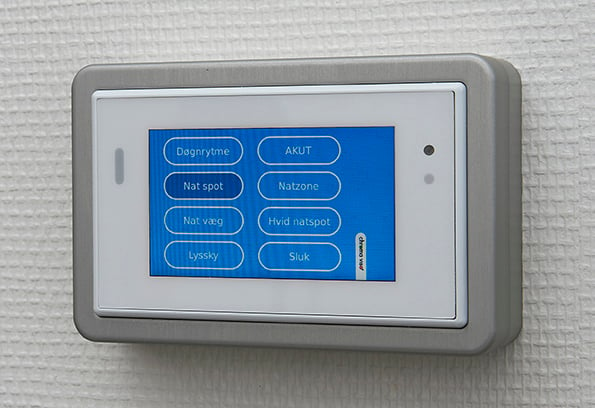At the Intensive Therapy unit in Holstebro, there is a strong emphasis on the significance of light for the patients. The latest addition to the ward is the installation of Ergonomic Circadian Lighting in room 302 - and now it's time to put the benefits of this lighting to the test.
In the Intensive Therapy unit in Holstebro, the sun rises at a specific time in room 302. Throughout the day, the lighting follows the rhythm of the sun to support the patients' need to normalize their circadian rhythm. For the night, a special night light has been developed that doesn't disrupt the production of the sleep hormone melatonin, which regulates the circadian rhythm. Additionally, there are different zone-divided activity lights that can be used as needed. This concept, called Ergonomic Circadian Lighting, has been successfully installed in neurosurgical, neurorehabilitation, cardio/thoracic, and general intensive care units across the country. In Holstebro Intensive, Ergonomic Circadian Lighting has been installed for testing, and there is a natural skepticism until the lighting has proven its worth. The department is not initially lacking in light, but they strive to be open to new initiatives that can benefit their patients.
High awareness of the significance of light
As the Intensive Therapy unit receives patients from all specialties of the hospital, Birthe Brinch Vestergaard, the head nurse, explains:
— Our patients are in the most acute and critical phase of their illness and therefore require intensive care and treatment. We already have a modern and well-equipped department that prioritizes lighting. When the department was renovated seven years ago, we took into consideration the importance of good lighting. The department is designed to maximize natural daylight, with the flexibility to dim the lights in patient rooms, hallways, and staff areas. We have always been aware of the significance of light for our patients. Just outside the ward, we have a glass corridor that allows for abundant natural light, leading to a sensory garden where patients with longer stays can enjoy the outdoors. So, we are not initially lacking in light. However, we are always open to new initiatives that can benefit our patients, which is why we are eager to try Ergonomic Circadian Lighting as a solution.
Ideal lighting conditions for the patients
— Ergonomic Circadian Lighting fits well with the principles we follow, such as "Basal Stimulation," which emphasizes the importance of shielding patients, taking individual considerations into account, and involving patients and their families. Sleep and light play a crucial role in this regard. We are also inspired by Helle Svenningsen's research on intensive delirium. We had Helle visit our department to provide training, and during that time, we learned about the significance of sleep and maintaining a stable circadian rhythm. It is essential to have a day-night variation with a distinction between day and night, preferably with ample amounts of natural daylight. Ergonomic Circadian Lighting provides the staff with a range of options to create the best lighting conditions for the patients. The night spot is useful when you need to see something on the patient during the night without causing disruption. The golden light creates a pleasant atmosphere. The principle is that the lighting follows the rhythm of the sun throughout the day, so the sun is programmed to rise in the room in the morning and set in the evening at specific times. Before we can evaluate Ergonomic Circadian Lighting further, the installation needs to be fully operational, and we need time to gain experience with its usage. However, we certainly want to provide the most optimal lighting conditions for our patients," concludes Birthe Brinch Vestergaard.

The installation of Ergonomic Circadian Lighting in the Intensive Therapy unit in Holstebro utilizes the latest LED technology with an accompanying control panel. The workflow on each department forms the basis for programming Ergonomic Circadian Lighting. The sun rises and sets at specific times each day, ensuring that patients maintain a stable circadian rhythm. Consideration can also be given to the changing seasons.

